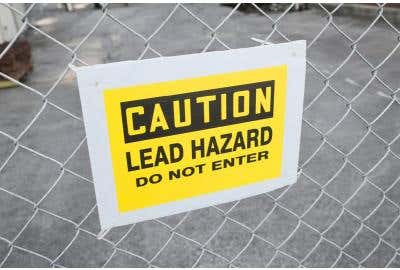Hazards of Lead on the Job Site


From roofing to plumbing and many other applications, it’s hard to work on a job site in the construction industry and not encounter lead in some capacity. When handled safely, lead poses minimal threats to your health. However, overexposure to lead is quite a different story, and the consequences can be deadly. Here, ClickSafety takes a look at the dangers of lead that may be lurking on your job site.
Why Lead Is Dangerous
As a heavy metal, lead has a long history of poisoning workers on the job. Its remnants can be contained in dusts, fumes and mists, and workers often inhale lead during:
- Painting, spray painting and paint removal
- Demolition and renovation
- Plumbing and electrical work
- Heating and air conditioning work
- Blasting, welding, burning or cutting of steel
- Cleanup of abrasive materials
Once inhaled, lead is absorbed by the lungs and eventually circulates throughout the body via the bloodstream. Less commonly, lead may also be ingested and absorbed by the digestive system.
No matter how lead enters the body, the consequences are severe. It can settle in organs and tissues, including the kidneys and the reproductive, cardiovascular and central nervous systems, eventually causing irreversible damage and even leading to death.
Symptoms of Lead Exposure
If you regularly encounter lead on the job and have concerns about health and safety, it’s important to be able to identify symptoms of exposure. Doing so can reveal areas of your operation that require added safety measures including personal protective equipment and job site set-up. Most importantly, education and awareness surrounding the symptoms of lead exposure can save lives.
Common symptoms include tremors, headache and constipation, loss of appetite and a metallic taste in the mouth. You may also experience nausea, dizziness and weakness, sore joints and muscles and intense abdominal pain. If you notice any of these symptoms, see a doctor right away. Symptoms will not resolve on their own and require immediate medical attention.
Stay Safe With Lead Safety Courses
One of the best ways to protect yourself from lead on the job is to stay up-to-date on safety training. ClickSafety’s training courses play an important role in understanding and mitigating risk to workers. Our lead safety and management courses include:
- Lead Hazards for Construction
- Advanced Lead Awareness for Construction
- Lead Awareness for General Industry
- Lead Awareness for General Industry (Advanced)
- Subpart D Construction Health Hazards
- Other Construction Health Hazards
- Lead Exposure Hazards Toolbox Talk
During these courses, site workers, foremen and supervisors can learn best practices for staying safe around lead, including how to avoid and address exposure, identify lead hazards and eliminate them. You'll also learn more about using respirators and other safety equipment, as well as relevant OSHA and EPA standards specific for lead. Upon completion of the course, you'll understand your rights and responsibilities on job sites where there is a potential for lead exposure and have the necessary knowledge to protect yourself, your coworkers and the general public who may face exposure as a “passer-by”.
Are you ready to learn more about managing the dangers of lead and promoting safer conditions at work? If so, ClickSafety offers a wide range of safety courses focused around OSHA requirements to help employers and workers limit risk and maintain a healthier, more productive work environment for everyone. For more information, contact us today or call 800-971-1080.

